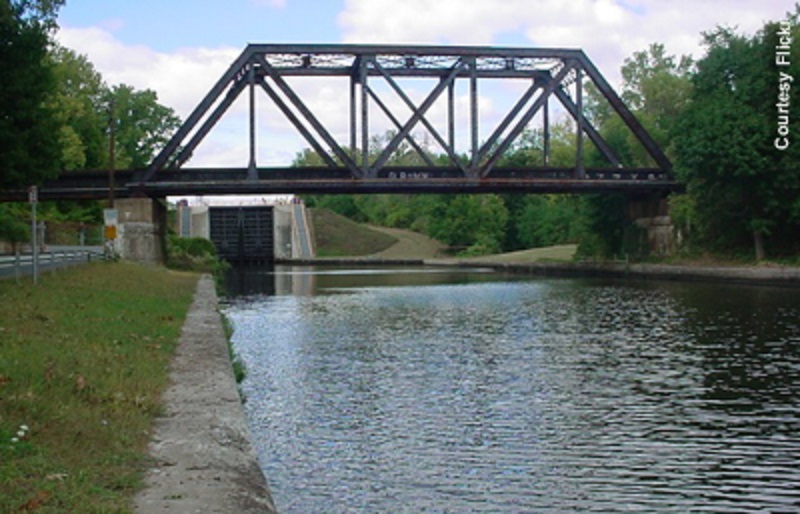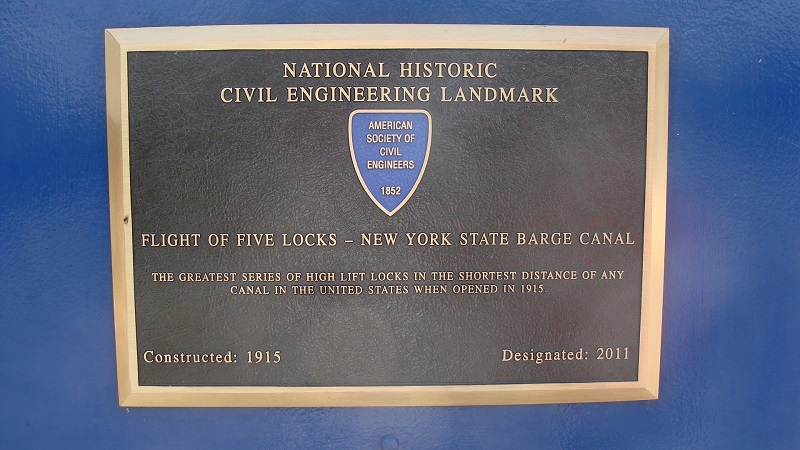Flight of Five Locks
42 48 02.8 N, 73 41 29.1 W

When opened, the Flight of Five Locks represented the greatest series of high lift locks in the shortest distance of any canal in the United States.
The confluence of the Mohawk and Hudson rivers was the site of distinct advances in transportation of the early 19th Century. The Erie Canal in 1825 and the Mohawk and Hudson Railroad in 1831 were both of national significance.
The Erie Canal started at a boat basin in Albany. It was raised at a lock at the end of the basin and the canal followed the western bank of the Hudson River to Cohoes. To raise the canal from just above sea level to an elevation greater than the Mohawk River required a large flight of locks running along the southerly bank of the Mohawk around the Cohoes Falls. To lift the canal boats over 140 feet required 25 locks with individual lifts of up to 8 feet. The locks were placed very close to one another with little storage for water between them. This, plus the fact, that there was only a single lock at each location slowed down traffic significantly as boats traveling in both the easterly and westerly direction had to use the same locks. In good times it would take over a day to pass from Schenectady through all of the locks to Albany. For this reason, among others, in 1831, the Mohawk and Hudson Railroad was established between Schenectady and Albany. Passengers would either board the canal boats at Schenectady for the trip west or disembark the canal boats at Schenectady and take the railroad on its trip easterly to Albany.
Very soon after the canal was opened in 1825 it became clear that it was too small and had to be enlarged. Starting in 1835 the enlargement process began. The enlarged locks at Cohoes were placed west of the city and were spaced out so that 16 locks (Nos. 3 to 18) raised the boats to the shore of the Mohawk River. The enlargement of the canal was completed in 1862 and in 1895 many of the locks were doubled, and after that many of the westbound lock chambers were doubled in length. Even with these enlargements, a need for more capacity was determined in the late 1890s and early 1900s, which led to the New York State Barge Canal.
Originally, dating from approximately 1902, a series of doubled high lift locks were designed through Cohoes to reach directly to the Mohawk River that was to be dammed up at Crescent. Whitford's History of the Erie Canal stated, "The territory in the vicinity of the falls had been frequently surveyed but not until the studies of 1904 did it occur to anybody to utilize a natural depression that extended a good part of the way between the Hudson and the Mohawk. The new location at once commended itself and was speedily adopted. Along this stretch of about two miles and a half there has been constructed a section of canal which is abounding in features of especial interest to the engineer, the main attraction being the greatest series of high lift locks in the world, five locks elevating boats through a height of 169 feet."
The flight of five locks continue to serve pleasure craft and still provide the highest lift in the shortest distance of any canal built in the United States.


